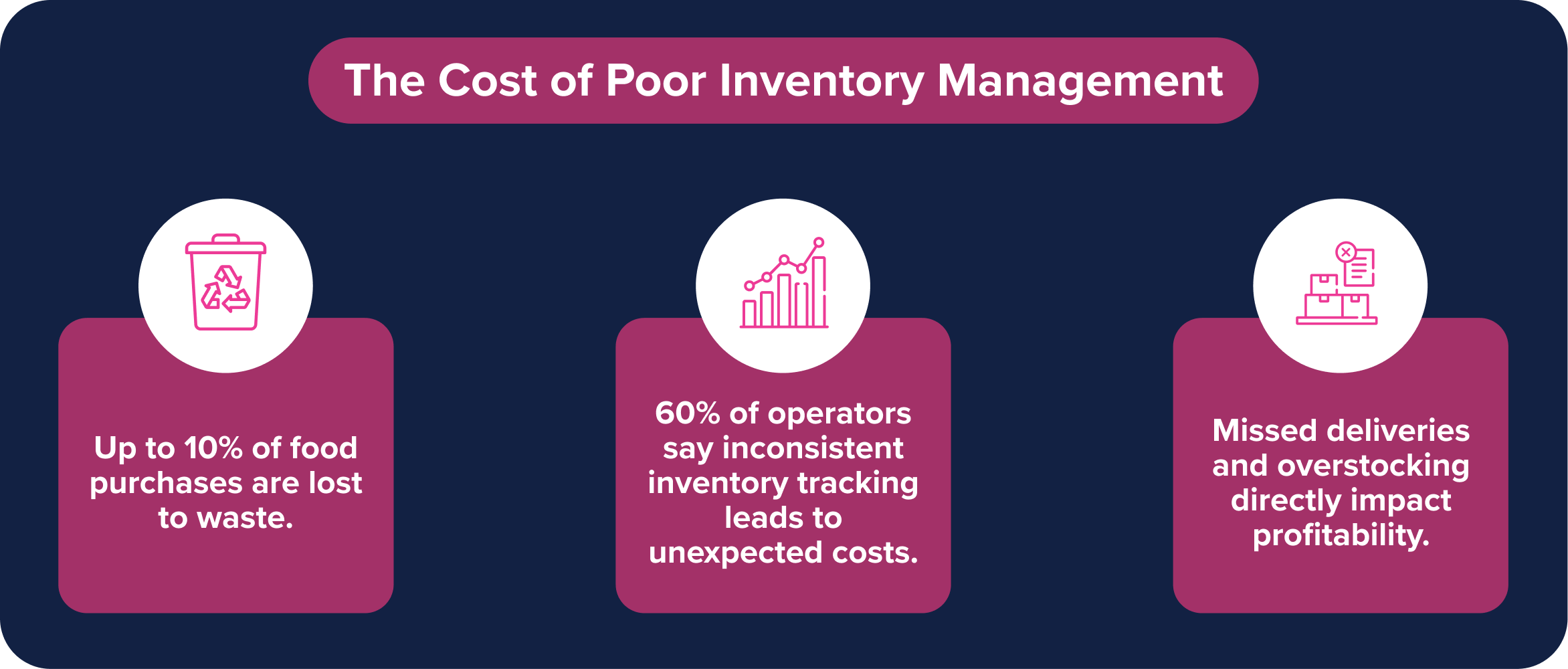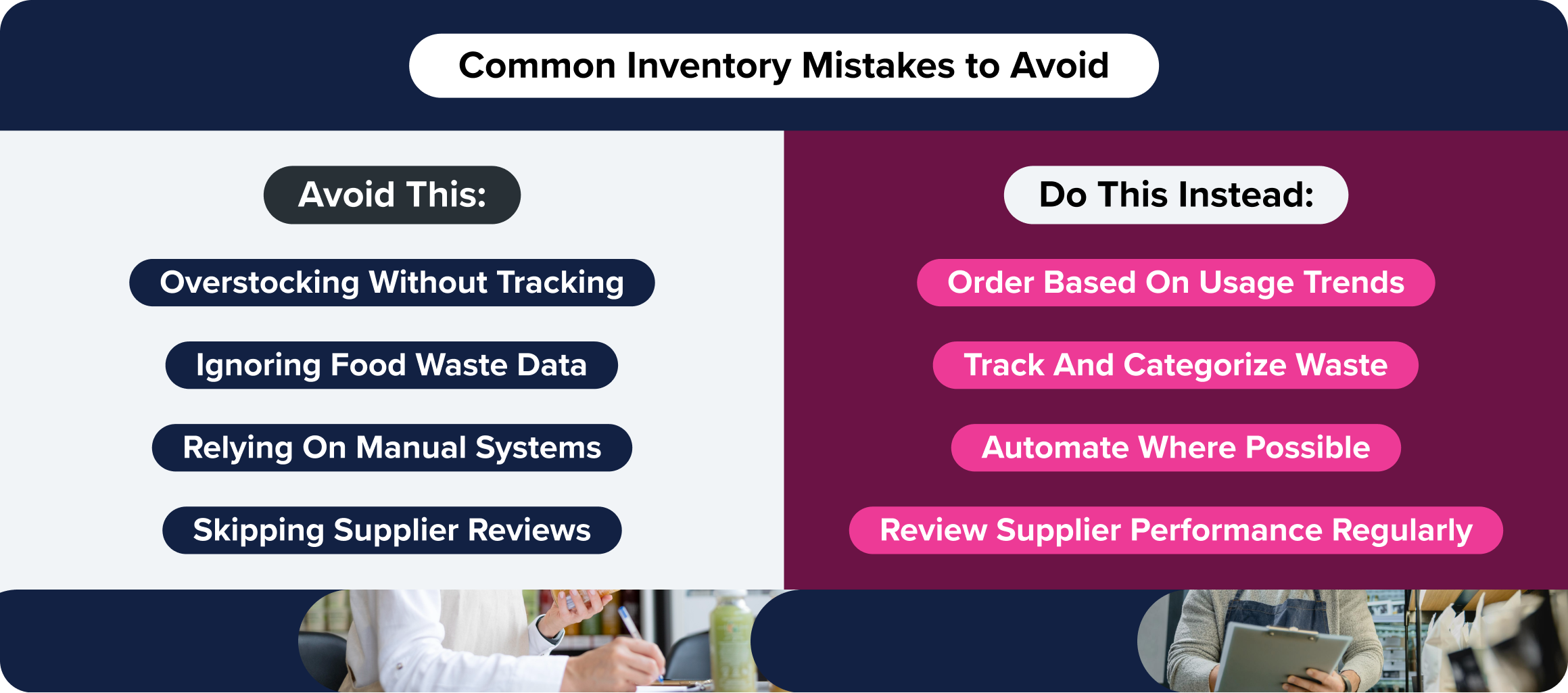Ask anyone who’s worked in a kitchen—inventory can make or break your month. It’s not just about what’s in the cooler; it’s about how those ingredients connect to your costs, your cash flow, and the pace of your operation. Food prices change constantly, guests come and go in waves, and one missed delivery can throw everything off. Managing inventory well isn’t busywork—it’s survival.
Why Inventory Management Matters for Restaurants
When margins are razor-thin, every ounce matters. A solid inventory process helps you stay on top of costs, spot waste early, and avoid running short on the items that actually make you money. It’s not glamorous, but it’s one of those behind-the-scenes systems that keeps your kitchen steady when things get chaotic.
When you really know what’s sitting on your shelves—and how quickly it’s moving—you start ordering smarter and negotiating better. It’s less about reacting to what’s missing and more about planning what’s next. That’s how operators find control in a business that never really stops moving.

Basic Inventory Management Tips for Restaurants
Inventory might not feel exciting, but it’s the part of the job that separates smooth operations from daily chaos. Here’s where to focus your energy.

Track Stock Regularly
There’s no shortcut here—consistency wins every time. Count on a schedule, do it the same way each time, and stick with a small, reliable crew. It doesn’t have to take hours. When you keep counts organized by category, you’ll catch problems—like waste, shrinkage, or missing product—before they grow legs.
Use Inventory Management Software
Spreadsheets had their moment. These days, smarter systems track usage automatically, calculate your true cost of goods sold (COGS), and flag weird spikes before they wreck your margins. The best part? You don’t have to spend your Sunday buried in numbers to see where you stand.
Set and Maintain Par Levels
Par levels are basically your safety net. They tell you how much you need to meet demand without over-ordering or running out of key ingredients. Start simple: look at your top movers and build from there. Over time, you’ll spot patterns that help you balance cash flow and reduce waste.
Pro Tip: Let your data—not your gut—tell you when to adjust. Your POS or inventory system can help track those shifts automatically.
Control Food Waste
Every operator knows waste happens—it’s just a matter of how much. Spoilage, prep mistakes, overproduction, plate returns… it all adds up. The trick is figuring out why it’s happening. Once you track that, you can tweak your ordering or prep lists and watch your profit margin tighten up. Cutting waste doesn’t just save money—it makes your operation leaner and more predictable.
Apply FIFO (First In, First Out)
The rule’s been around forever because it works. Rotate stock so the oldest items go first. It’s simple, it’s fast, and it keeps ingredients fresh. You’d be surprised how many kitchens skip this and end up paying for it in spoilage.
Train Staff on Proper Inventory Handling
You can have the best systems in the world, but if your staff isn’t following them, it won’t matter. Label and date everything, store it right, and make portion control part of the culture. Everyone who touches food touches your inventory, so make sure they know it.
Conduct Regular Inventory Audits
Audits don’t have to be a nightmare. Think of them like a mid-shift check—quick, simple, and eye-opening. Compare what’s on the shelf with what’s recorded, and check for things like wrong pricing or substitutions. You’ll build accountability and catch issues before they hit your P&L.
Integrate Inventory with POS Systems
When your POS and inventory system talk to each other, you suddenly see the whole picture. Every sale automatically updates your stock levels, helping you pinpoint what’s selling, what’s sitting, and how it all affects your costs. Plus, it saves hours of manual work, which—let’s be real—nobody misses.
Monitor Supplier Performance
A late truck or a swapped item can derail an entire service. Keep an eye on supplier consistency, delivery accuracy, and product quality. Tools that track supplier performance or offer visibility into your supply chain can help you spot problems before they turn into crises. You’ll know who’s holding up their end—and who isn’t.
Common Mistakes to Avoid in Restaurant Inventory Management

Even the best-run kitchens have blind spots. Here are a few to watch for:
- Overstocking Without Tracking: More stock doesn’t mean more security—it just means more waste.
- Ignoring Food Waste Data: You can’t fix what you don’t measure.
- Not Using Technology: Manual systems slow you down and leave room for errors.
- Skipping Supplier Reviews: A little extra attention here saves a lot of money later.
Turning Inventory into an Advantage
Inventory management isn’t the flashiest part of restaurant life, but it’s the quiet power move that keeps your business steady. When you mix consistent habits with the right data and visibility, you gain the insight to run leaner, smarter, and more profitably.
Get the process right, and suddenly inventory stops being a chore—it becomes your edge.
Want to take control of your inventory? Click here to join the Buyers Edge Platform and see how data-driven insights can transform your operation.

